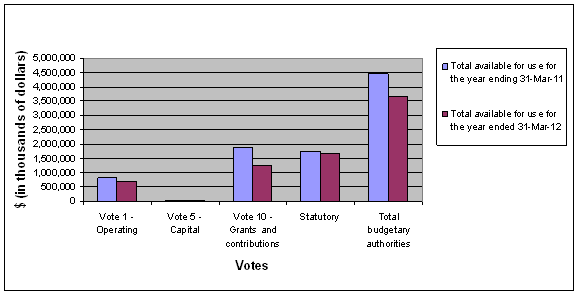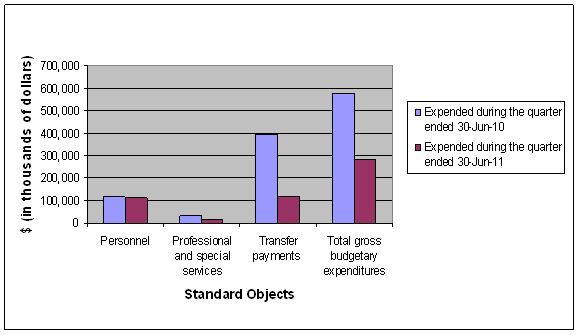Natural Resources Canada Quarterly Financial Report (Unaudited) For the Quarter Ended June 30, 2011
Statement outlining results, risks and significant changes in operations, personnel and program
1. Introduction
This quarterly financial report should be read in conjunction with the Main Estimates and Supplementary Estimates A. It has been prepared by management as required by section 65.1 of the Financial Administration Act and in the form and manner prescribed by Treasury Board. This quarterly financial report has not been subject to an external audit or review.
1.1 Authority, Mandate and Program Activities
Natural Resources Canada (NRCan) seeks to enhance the responsible development and use of Canada’s natural resources and the competitiveness of Canada’s natural resources products. We are an established leader in science and technology in the fields of energy, forests, and minerals and metals and use our expertise in earth sciences to build and maintain an up-to-date knowledge base of our landmass. NRCan develops policies and programs that enhance the contribution of the natural resources sector to the economy and improve the quality of life for all Canadians.Footnote 1
Further details on NRCan’s authority, mandate and program activities can be found in Part II of the Main Estimates.
1.2 Basis of Presentation
This quarterly financial report has been prepared by management using an expenditure basis of accounting. The accompanying Statement of Authorities includes NRCan’s spending authorities granted by Parliament, and those used by NRCan are consistent with the Main Estimates and Supplementary Estimates A for the 2011-2012 fiscal year. This quarterly report has been prepared using a special purpose financial reporting framework designed to meet financial information needs with respect to the use of spending authorities.
The authority of Parliament is required before moneys can be spent by the Government. Approvals are given in the form of annually approved limits through appropriation acts or through legislation in the form of statutory spending authority for specific purposes.
When Parliament is dissolved for the purposes of a general election, section 30 of the Financial Administration Act authorizes the Governor General, under certain conditions, to issue a special warrant authorizing the Government to withdraw funds from the Consolidated Revenue Fund. A special warrant is deemed to be an appropriation for the fiscal year in which it is issued.
NRCan uses the full accrual method of accounting to prepare and present its annual unaudited departmental financial statements that are part of the Departmental Performance Report. However, the spending authorities voted by Parliament remain on an expenditure basis of accounting.
2. Highlights of Fiscal Quarter and Fiscal Year To Date Results
As per Table 1 and shown in Graph 1 below, NRCan had authorities of $4,468 million in 2010/11 compared to $3,659 million in 2011/12 for a net decrease of $809 million.
Graph 1
Variances in Authorities as at June 30, 2011

text version - Graph 1
Graph 1 Variances in Authorities as at June 30, 2011
| (in thousands of dollars) | Fiscal year 2010-2011 | Fiscal year 2011-2012 |
|---|---|---|
| Total available for use for the year ending 31-Mar-11 |
Total available for use for the year ended 31-Mar-12 |
|
| Vote 1 - Operating | 820,721 | 699,342 |
| Vote 5 - Capital | 16,036 | 19,892 |
| Vote 10 - Grants and contributions | 1,877,636 | 1,267,523 |
| Statutory | 1,754,085 | 1,672,691 |
| Total budgetary authorities | 4,468,478 | 3,659,44 |
As per Table 2, and included in the Graph 2 below, personnel, professional and special services and transfer payments are the most significant categories of expenditures which represent 88% (or $246 million) of the total expenditures for the quarter of 2011/12 as compared to 96% (or $544.4 million) for the same quarter in 2010/11.
Graph 2
Variances in Expenditures for Significant Standard Objects as at June 30, 2011

text version - Graph 2
Graph 2 Variances in Expenditures for Significant Standard Objects as at June 30, 2011
| (in thousands of dollars) | Fiscal year 2010-2011 | Fiscal year 2011-2012 |
|---|---|---|
| Expended during the quarter ended 30-Jun-10 |
Expended during the quarter ended 30-Jun-11 |
|
| Personnel | 116,183 | 113,464 |
| Professional and special services | 33,441 | 14,224 |
| Transfer payments | 394,738 | 118,286 |
| Total gross budgetary expenditures | 574,082 | 280,622 |
Personnel expenditures are comparable comparing the first quarters of 2010/11 ($113.5 million) and 2011/12 ($116.2 million).
For the professional and special services, the decrease of $19.2 million from 2010-2011 to 2011-2012 is mainly due to reduced expenditure levels related to the Nuclear Legacy Liability Program in the first quarter of the current year.
The decrease of $276.4 million in transfer payments from 2010/11 to 2011/12 is attributable to payments of $78.7 million made in the first quarter of 2010-2011 for the ecoENERGY Home Retrofit Grant Program and $97.2 million under the Newfoundland Fiscal Equalization Offset payment obligations for which NRCan had no further obligations after March 31, 2011. Also, additional transfer payments obligations under the Atlantic Accord Acts which are affected by oil and gas prices and levels of production were $96.9 million lower in the first quarter of the year compared to the first quarter of 2010/11.
3. Risks and Uncertainties
This Departmental Quarterly Financial Report reflects the results of the current fiscal period in relation to the Main Estimates and Supplementary Estimates A for which full supply was released on June 27, 2011.
Budget 2010 announced that the operating budgets of departments would be frozen at their 2010-11 levels for the fiscal years 2011-12 and 2012-13. Management is reviewing various options to adjust to this constraint in funding.
NRCan has a series of instruments to help manage risks. The objective is to ensure the ongoing assessment and management of risks at all levels within the organization. The integrated Risk Management Policy Framework sets the parameters for this and guides the integration of risk management activities with management practices, such as priority setting, business planning, resource allocation and performance reporting.
The department identifies in its Corporate Risk Profile the key operational, strategic and external risks, as well as their related impact and likelihood assessments and mitigation strategies. The Corporate Risk Profile currently identifies and addresses 17 key corporate risks.
One of these key risks relates its ability to manage changes in short-term funding as noted in section 2. The decrease in authorities in operating expenditures is mainly attributable to the sunsetting of some programs as well as reallocations under Strategic Review.
NRCan has a long track record of adapting to significant changes to its funding levels, as the major share of its authorities is time-limited. The department has put in place measures to manage uncertainties related to the management of long-lived capital assets and highly qualified personnel, for example by managing indeterminate staff at the corporate-level, conducting regular financial monitoring and developing new proposals focused on government priorities. The 2011 Budget included more than $660 million over two years in new funding for the department (not reflected in the tables included in this report).
Finally, a new financial system was implemented in April 2011 to replace one that was inadequate for the department’s needs. Its implementation poses some risks but the department has taken a multi-pronged approach to managing them.
4. Significant Changes in Relation to Operations, Personnel, Programs
Budget 2011, announced in June 2011, included significant new funding for NRCan programs, notably for Regulatory Actions to Drive Energy Efficiency ($86M/2 years), Research, development and deployment for clean energy and energy efficiency ($97M/2 years), ecoENERGY Home Retrofit ($400M/1 year), International Climate Change ($8.8M/2 years), Helping Canadians Adapt to a Changing Climate ($12M/2 years), and Forest Innovation and Market Diversification ($60M/1 year).
Funding authority for these programs will be sought over the next few months, and the programs will be implemented soon thereafter.
A new Deputy Minister, Serge P. Dupont, was appointed in October 2010, and a new Associate Deputy Minister, Karen Ellis, was appointed in February 2011.
Approved by:
Serge P. Dupont
Deputy Minister
Bill Merklinger, CMA
Chief Financial Officer
August 29, 2011
Date signed
Ottawa, Canada
| (in thousands of dollars) | Fiscal year 2011-2012 | Fiscal year 2010-2011 | ||||
|---|---|---|---|---|---|---|
| Total available for use for the year ending* | Used during the quarter ended | Year-to-date used at scope="col" | Total available for use for the year ended* | Used during the quarter ended | Year-to-date used at | |
| March 31, 2012 | June 30, 2011 | quarter-end | March 31, 2011 | June 30, 2010 | quarter-end | |
| Operating expenditures - Vote 1 | 699,342 | 159,021 | 159,021 | 820,721 | 158,644 | 158,644 |
| Capital expenditures - Vote 5 | 19,892 | 756 | 756 | 16,036 | 57 | 57 |
| Grants and contributions - Vote 10 | 1,267,523 | 48,053 | 48,053 | 1,877,636 | 127,299 | 127,299 |
| Total Budgetary statutory authorities | 1,672,691 | 70,235 | 70,235 | 1,754,085 | 281,855 | 281,855 |
| Total Budgetary authorities | 3,659,448 | 278,065 | 278,065 | 4,468,478 | 567,855 | 567,855 |
* - Includes only Authorities available for use and granted by Parliament at quarter-end: Main & Supplementary Estimates A
| (in thousands of dollars) | Fiscal year 2011-2012 | Fiscal year 2010-2011 | ||||
|---|---|---|---|---|---|---|
| Planned expenditures for the year ending* | Expended during the quarter ended | Year-to-date used at | Planned expenditures for the year ended* | Expended during the quarter ended | Year-to-date used at | |
| March 31, 2012 | June 30, 2011 | quarter-end | March 31, 2011 | June 30, 2010 | quarter-end | |
| Budgetary expenditures: | ||||||
| Personnel | 386,403 | 113,464 | 113,464 | 398,631 | 116,183 | 116,183 |
| Transportation and communications | 26,600 | 3,351 | 3,351 | 68,593 | 6,149 | 6,149 |
| Information | 6,430 | 174 | 174 | 30,298 | 329 | 329 |
| Professional and special services | 309,972 | 14,224 | 14,224 | 246,879 | 33,441 | 33,441 |
| Rentals | 10,010 | 2,009 | 2,009 | 20,510 | 2,607 | 2,607 |
| Repair and maintenance | 5,142 | 201 | 201 | 15,309 | 627 | 627 |
| Utilities, materials and supplies | 16,762 | 2,023 | 2,023 | 41,045 | 2,652 | 2,652 |
| Acquisition of land, buildings and works | 19,892 | 756 | 756 | 16,036 | 54 | 54 |
| Acquisition of machinery and equipment | 25,085 | 812 | 812 | 74,304 | 1,530 | 1,530 |
| Transfer payments | 2,881,393 | 118,286 | 118,286 | 3,574,074 | 394,738 | 394,738 |
| Other subsidies and payments | 5,671 | 25,322 | 25,322 | 17,331 | 15,772 | 15,772 |
| Total gross budgetary expenditures | 3,693,360 | 280,622 | 280,622 | 4,503,010 | 574,082 | 574,082 |
| Less: | ||||||
| Revenues netted against expenditures | 33,912 | 2,557 | 2,557 | 34,532 | 6,227 | 6,227 |
| Total net budgetary expenditures | 3,659,448 | 278,065 | 278,065 | 4,468,478 | 567,855 | 567,855 |
* - Includes only Authorities available for use and granted by Parliament at quarter-end: Main & Supplementary Estimates A
Page details
- Date modified: